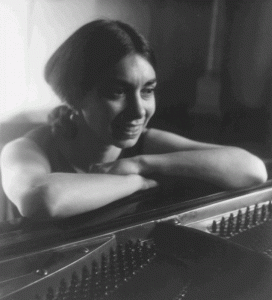At a dinner party in the Hamptons attended by your correspondent many years ago, the late and legendary editor Willie Morris averred–this was at a point in the evening when his beverage had been refreshed several times–that “things would have been a lot different if the South had won the war.” I assumed he was being ironic but the notion came back to me other night during the first of two concerts organized by the Library of Congress in tribute to Dina Koston, a prominent force in DC classical music for many years who died last year and– along with her husband– left the Library an endowment called the Dina Koston and Roger Shapiro Fund for New Music. The thought I had: So, this is where new music might have gone if there had never been a Terry Riley or Steve Reich or Philip Glass, if there had been no Internet or cheap recording technologies to allow almost anyone to circumvent the musical “establishment,” if a few of the trains to Princeton had not been diverted to New Haven (to mangle Wallace Stevens), if “high modernism” had prevailed in the marketplace of music ideas the way it did in academia.
Before you academy types pounce, let me be clear that I’m not making a value judgement about “quality” (whatever that is but I know it when I hear it). The concert, which featured the superb Cygnus Ensemble playing Dina Koston’s final composition—paired with the short play called Ohio Impromptu by Samuel Beckett that inspired it–a premiere of the endowment’s first commission and several other new pieces, was brilliantly staged and performed and thoroughly entertaining. (Charles T. Downey has his usual bang-up review here. )
Nor am I suggesting that the living composers whose work was performed at the concert are old-fogeys who never crawled down from Uncle Milton’s knee. But, several of them were bounced there a few times and their journey into heresy is one of the things that distinguishes their later work. From what little I know about Dina Koston, I’m fairly sure she would have hated Frank Brickle’s Farai un vers (which he calls Neo-Medieval Psychedelia) and David Claman’s Gone for Foreign, both of which are warm, witty and thoroughly non-dogmatic. Harder to understand was the selection of Mario Davidovsky as the winner of the Koston-Shapiro fund’s first commission. His Ladino Songs were solid and elegant but the seventy-something winner of the 1971 Pulitzer Prize and many other honors is hardly in need of additional recognition. (They could have given the award to George Crumb, whose Ancient Voices of Children should have won the 1971 Pulitzer.)
For New Yorkers, the good news is that an extension of the Library of Congress/Cygnus Quartet program, called Sounding Beckett, will performed here at the Classic Stage Co. on two weekends in the Fall–(Fri-Sun): September 14-16 and 21-23. Three Beckett pieces will be staged–Ohio Impromptu, Footfalls and Catastrophe–and each will have two new works composed in response to it commissioned for this occasion by The Dina Koston and Roger Shapiro Fund for New Music.
But, enough music politics. What surprised me most pleasantly about the visit was what a lively and ambitious concert program the Library of Congress maintains. Most concerts are staged in the LOC’s Coolidge Auditorium, a comfortable mid-sized venue, that was filled both nights I was there. Anne McLean, who runs the concert series (with only a couple of people to help), is a warm and generous woman with an empathy for composers. musicians and other lost souls. She spotted me alone leaning against a pillar slurping my noodles at the reception, and pegged me for the Sequenza21 publisher and a man who needs a lot of hugs these days. I really like this woman.




